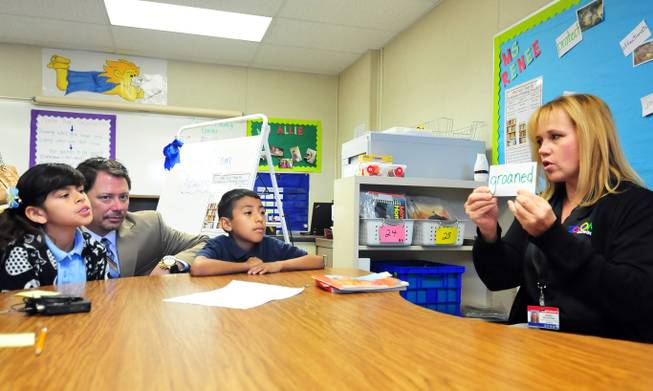
A reading tutor works with English-language learner students as Clark County Schools Superintendent Pat Skorkowsky looks on at a Zoom Reading Center on Wednesday, October 23, 2013, at Lunt Elementary School.
Wednesday, Oct. 23, 2013 | 3:21 p.m.
A tutor holds up a white notecard and points to a string of letters.
“What’s the word? she asks, looking at the five students sitting in a semicircle around her.
“Because,” a third-grade boy at Lunt Elementary School replies.
“Good,” the tutor says. “Now, how do you spell it?”
Small-group lessons like this one are taking place across the Las Vegas Valley, thanks to the creation of special reading centers that opened today at 14 elementary schools. The Zoom reading centers are part of a statewide literacy initiative to help thousands of English-language learner students catch up to their literate peers.
Clark County’s 53,000 English-language learner students have among the lowest test scores and graduation rates in the nation’s fifth largest school system. Research shows that if students can’t read by third grade, they are less likely to graduate from high school.
To close the achievement gap for non-English-speaking students, Nevada lawmakers approved $50 million in state funding earlier this year to help English-language learners.
The Clark County School District received the bulk of the funding: about $39 million over the next two years.
Using the money, the School District created 14 Zoom to Literacy schools boasting smaller class sizes, longer instruction time and tuition-free, full-day kindergarten and preschool classes.
The district also used the state funding to create 14 Zoom reading centers. Modeled after a UNLV pilot program, the $200,000 reading centers provide hundreds of English-language learner students with books and intensive tutoring.
Zoom schools’ Academic Manager Danielle Miller said the reading centers will help English-language learners succeed in the classroom.
“We would love to have these reading centers in all CCSD schools,” Miller said.
At Lunt Elementary School in the eastern valley, 75 students from first through third grades pass through the Zoom reading center every day. They are pulled out of their regular classrooms for 30 minutes a day for extra reading and writing lessons.
A team of licensed, retired and student teachers as well as trained specialists work with struggling students on their reading, writing, vocabulary and comprehension skills.
Each student is given 30 minutes of additional reading time above the 110-minute minimum required for all students.
The goal is to get these students caught up as fast as they can, so other students can take their place. Of the 699 students at Lunt, more than two-thirds — 468 students — have a limited proficiency in English.
“We have a lot of kids who need this,” Lunt principal Thelma Davis said. “We couldn’t have done (these reading centers) without the extra funding.”
These specialized reading programs have seen success in other states like Utah and Florida, said UNLV law professor Sylvia Lazos, who helped create six reading skills development centers in the School District.
These pilot reading centers, funded by a $1 million annual federal grant from the district, became the basis for the new Zoom reading centers, as federal funding ran out for the pilot and was replaced by state funding.
Often, English-language learner students are misdiagnosed as special-needs students because of their language deficiency, Lazos said. Instead of being placed in a special-needs classroom, English-language learners should be given specialized programs to help them learn English.
“It’s not that (English-language learners) have cognitive problems — they got such a late start,” Lazos said.
“We know that language isn’t a barrier to intelligence,” Superintendent Pat Skorkowsky added. “With some of the money that (Gov. Brian Sandoval) and the Legislature gave us this last session, we’ve got to focus in on our second-language population. That has to be a priority No. 1.”
Nevada Senate Majority Leader Mo Denis, who was among several public officials in attendance at a Zoom reading center ribbon-cutting today, said he was an English-language learner student who could have benefited from a special reading center.
“This is the centerpiece of our Zoom program,” said Denis, who championed the bill that funded the literacy initiative. ”This is the thing that will make a difference in (a student’s) life. If kids can read, they can do anything.”


Join the Discussion:
Check this out for a full explanation of our conversion to the LiveFyre commenting system and instructions on how to sign up for an account.
Full comments policy